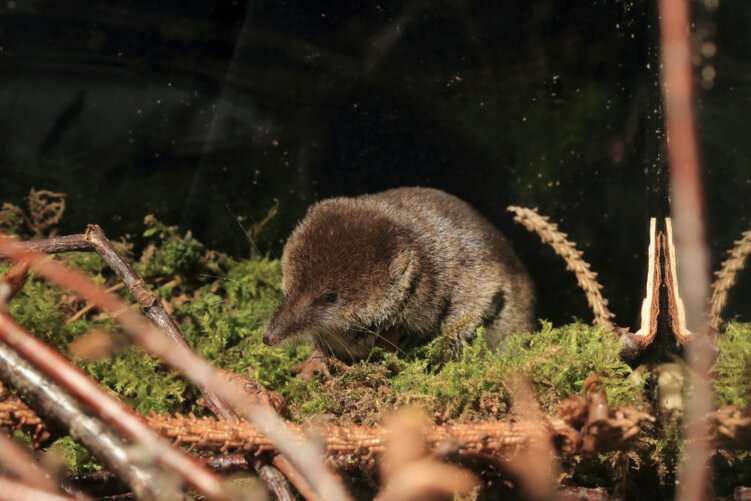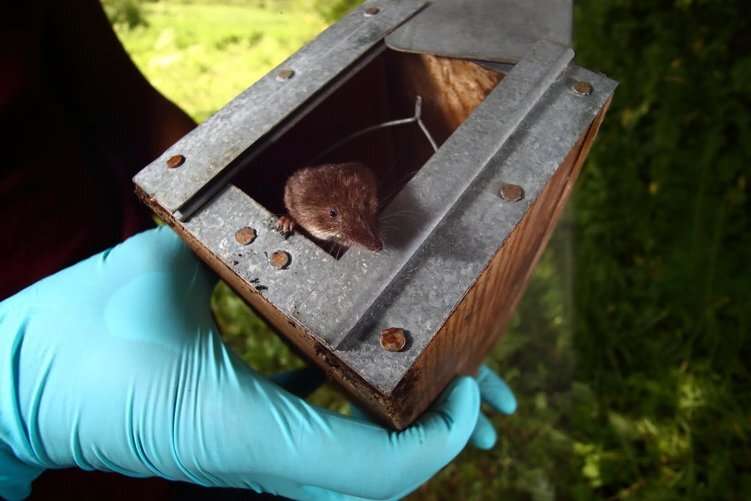The common shrew is a survivor: to save energy, it does not hibernate, but simply becomes smaller. Credit: Christian Ziegler
Common shrews have one of the highest metabolic rates among mammals. They must therefore consume a considerable amount of energy for their relatively low body weight. Because their fat reserves are quickly used up, they often starve to death after only a few hours without food. Nevertheless, forest shrews and their close relatives are highly evolutionarily successful and quite widespread, especially in the northern hemisphere.
Dina Dechmann, a scientist at the Max Planck Institute of Animal Behavior in Radolfzell, hopes to find out how animals deal with large fluctuations in food supply and other resources. For example, how do tiny shrews manage to overcome the cold and food shortages in winter? But studies with wild shrews consume a great deal of time and resources. Because of their strong territorial behavior, the animals must be kept in large individual enclosures throughout the experiments.
Shrink in autumn, grow in spring
Unlike many other animals, common shrews neither store food nor hibernate. Instead, they adapt in a completely different way: After their birth in summer, they grow rapidly to a maximum size. But in autumn, they begin to shrink and lose approximately ten to 20 percent of their body weight. Not only fat and muscle mass is reduced; internal organs such as the brain also shrink. From February onwards, the shrews begin to grow again until they reach their maximum size in spring. However, some tissues, such as the brain, only partially grow again. This seasonal change in body size, which is extremely rare in the animal kingdom, is also known as Dehnel's phenomenon.
However, this strategy seems a bit paradoxical. Despite thick winter fur, one would expect the shrews to cool down more easily in winter temperatures because smaller animals have an unfavorable body surface to body mass ratio. Because of this, they lose more heat to the cold ambient air. In fact, the relationship between body weight, temperature, and metabolic rate is a fundamental law of ecology.
For their study, the researchers caught the shrews in live traps and recorded their metabolism for several hours. They then released the animals again. Credit: Christian Ziegler
Constant energy consumption
In order to find out how the seasonal change in body size affects the energy consumption of shrews, Dechmann and her team measured the animals' metabolism at the respective outdoor temperatures of the different seasons. The results were surprising. "The common shrew somehow manages to cheat evolution," says Dechmann. Despite their reduced body size, shrews do not consume more energy per gram of body weight in winter—even though temperatures can fluctuate by more than 30 degrees. This is not because they are less active in winter. The video recordings of the researcher show that although the shrews rest a little more, this can only explain a small part of the differences in energy requirements.
The scientists suspect that shrews constantly produce excessive amounts of heat because of their high metabolic activity and therefore do not need to increase their metabolic rate in winter. A smaller body size simply means that they must consume less energy overall. This is advantageous considering the scarce food supply in winter. "How this works exactly is still unclear. There are still some open questions we would like to investigate in further experiments," says Dechmann. The special metabolism of the forest shrews might even shed light onto research in human diseases in which metabolism plays a role.
More information: Paul J. Schaeffer et al. Metabolic rate in common shrews is unaffected by temperature, leading to lower energetic costs through seasonal size reduction, Royal Society Open Science (2020). DOI: 10.1098/rsos.191989
Journal information: Royal Society Open Science
Provided by Max Planck Society

























